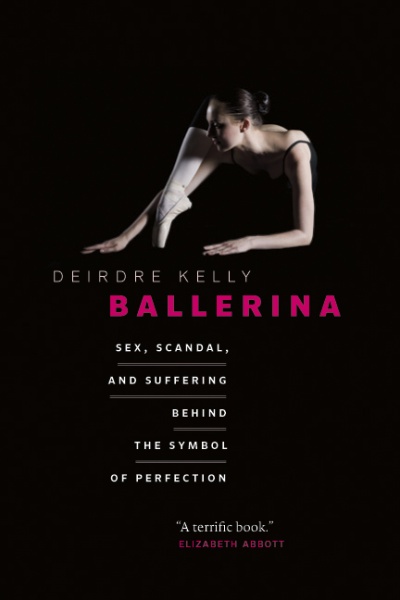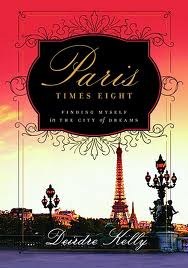My Books
Ballerina: Sex, Scandal and Suffering Behind the Symbol of Perfection (2012)
A controversial look at the brutal backstage existence of some of the world’s most celebrated ballerinas.
Throughout her history, the ballerina has been perceived as the embodiment of beauty and perfection. She is the feminine ideal — unblemished and ethereal, inspiration incarnate. But the reality is another story. Beginning with the earliest ballerinas, who often led double lives as concubines, Deirdre Kelly goes on to review the troubled lives of nineteenth-century ballerinas, who lived in poverty and worked under torturous and even life-threatening conditions. In the twentieth century, George Balanchine created a contradictory ballet culture that simultaneously idealized and oppressed ballerinas, and many of his dancers suffered from anorexia and bulimia or underwent cosmetic surgery to achieve the ideal ethereal form. At the beginning of the twenty-first century, ballerinas are still underpaid, vulnerable to arbitrary discrimination and dismissal, and expected to bear pain stoically — but much of this is beginning to change.
As Kelly examines the lives of some of the world’s best ballerinas — Anna Pavlova, Marie Camargo, Gelsey Kirkland, Evelyn Hart, and Misty Copeland, among others — she argues for a rethinking of the world’s most graceful dance form — a rethinking that would position the ballerina at its heart, where she belongs.
What the Critics Say About Ballerina:
“In a painfully riveting book, Canada’s dance critic Deirdre Kelly sheds new light on the private struggles of ballerinas.” — Flare Magazine
“This provocatively titled, impeccably researched history of the ballerina romps through centuries’ worth of ballet’s dirty little secrets … There are many engrossing stories in Ballerina. Ballet lovers will not be disappointed by this compelling read.” — Winnipeg Free Press
“[Kelly is] fresh and adept when summoning the art’s spellbinding yet harrowing earlier centuries.” — Publishers Weekly
“…her detailed account of how ballet transitioned from being a means of teaching aristocratic boys and men proper form for fencing and military maneuvers to an avenue of social advancement for lower-class women is engaging and informative … Ballerina is an entertaining book…the conversational tone and an abundance of tabloid-worthy gossip makes this a worthwhile read for avid fans of dance looking for an accessible and fun, if not exhaustive, history of ballet.” — Quill & Quire
“…fast-paced and fascinating…a pleasurable read for any balletomane.” — Library Journal
“Much like the mesmerizing figures that inhabit the world of ballet, the beauty of the art form attracts us but the unknown allure what goes on backstage forever holds our intrigue. It’s this vast and often dark history that Canadian arts writer Deirdre Kelly delves into and brings to the surface in her latest book, Ballerina.” — Elle Canada
“Critic Turned Advocate for Ballerinas’ Rights” — Dance Chronicle
“… a thoroughly researched and well-presented primer on dance history.” — Santa Fe New Mexican
Interview with Deirdre about her Ballerina book (by the Greystone Books publicity team)
What is your book about?
It’s a behind-the-scenes history of the ballerina, from the court of Louis XIV to the present day. It lifts the curtain on the earthy reality behind the ethereality, everything from institutionalized prostitution in the 18th and 19th centuries when the Paris Opera ballet company was known as the brothel of France to institutionalized starvation in the 20th century as a result of the influence of thechoreographer, George Balanchine.
Why the ballet world?
I am, by profession, a dance critic, and have written on all aspect of dance, including ballet, for close to 30 years. I am fascinated by dancers, ballerinas in particular, and as a child I used to obsessively draw them, along with flying fish — one a rarity of nature, the other a rarity of art — compelled by theirstrange beauty. I thought of ballerinas, even then, as beautiful but strong ideal images of a femininity I wanted to live up to.
What is it you admire about ballerinas?
Ballet is very hard to do and yet these women in their pointe shoes strive to make it look effortless and graceful. I admire their tenacity and their dedication along with their artistry. But when I became a professional dance critic at age 24, I saw that, behind-the-scenes, the ballerina was not always accorded the respect I felt she deserved. I saw great artists fired for being deemed fat even when whippet thin by overbearing artistic directors who seemed to take pleasure in pulling these creatures of the air down to earth, and down to size. This shocked and appalled me, and I wanted to explore inmore depth a culture that to me seems inherently quite schizophrenic — putting ballerinas on a pedestal in public, and demeaning them behind-the-scenes.
Did you ever dance yourself?
I was never a professional dancer, but since the age of 11 I have gone constantly to dance performances to feed my obsession. I am instinctively drawn to ballet; it compels me. I had a wonderful encounter once with the actress Shirley MacLaine, the high priestess of Hollywood, who spontaneously read my so-called aura, declaring that I had a past life as a Russian ballerina, in Paris, over a century ago. She said I had been very popular with audiences! I was dumb-struck when she said that, and only could mutter, “Well, that explains it, then.” My own daughter I named Isadora after the great Isadora Duncan, who abhorred ballet, and was a true dance pioneer. But that’s another story.
Paris Times Eight
A poignant and often amusing reminiscence of growing to womanhood through eight visits to Paris.
“Deirdre Kelly’s writing is fast-paced and full of colour and gives the reader an insider’s view. She gets it right.” —Sally Armstrong, author of Bitter Roots, Tender Shoots: The Uncertain Fate of Afghanistan’s Women
For Deirdre Kelly, Paris is not only a dream city but also the place where she attains a deeper understanding of herself. Having always defined herself in opposition to her mother, Kelly finds in the city itself her “other mother,” the mother of her imagination.
At nineteen, Kelly first arrives in Paris as a starry-eyed ingénue. In a subsequent visit she appears as a budding writer, eager for intellectual and sexual adventure, who interviews the legendary Nureyev and crashes an exclusive fashion show. In an emotionally charged return, Kelly takes her mother to Paris to meet her “other mother,” with not altogether happy results. She also takes her future husband, who has his own connection to the city. On her last trip, she is a mother herself.
During all these visits, Paris is the constant, but Kelly’s shifting emotional world creates varying perspectives on both the city and her evolving self. In Paris Times Eight Paris emerges as a principal character, an influence that inspires and guides Kelly on her path to growth and maturity.
What the Critics Say About Paris Times Eight:
“[Kelly] takes the reader on a colourful travelogue along the narrow streets of the Marais district, the spectacular Tuileries gardens and the bustling Galleries Lafayette department store…Paris Times Eight is a fast-paced, breezy read, its substance subtly woven into a tale of a city whose glamour and beauty never fades.” — Ottawa Citizen
“[Kelly’s] book, its chapters highlighting eight separate visits beginning in 1979 after high school graduation, is at times pensive, sardonic and laugh-out-loud funny, as it chronicles a real life with all its comedies and tragedies.” — Calgary Herald
“Written in a very engaging style … This charming travel memoir shows us how a person and a city can grow and change in tandem.” — Booklist
“In Kelly’s book, Paris comes alive as a character: detailed descriptions abound as Kelly captures the depth, vivacity, and uniqueness of Paris that its champions strive to relate to those who have never experienced it… I found that the greatest accomplishment of Paris Times Eight was its power to rouse in me the longing and hunger for Paris that drove Kelly for nearly thirty years. So, get reading – I’ll meet you at the airport.” — SheDoestheCity.com
Interview with Deirdre about her Paris Times Eight book (by the Douglas & McIntyre publicity team)
Why did you decide to write this book?
I wrote Paris Times Eight as a love song to the city that has long inspired me, and I realised that each visit coincided with a significant benchmark in my development as a woman. By travelling inward, and using Paris as my catalyst, I thought I might find meaning in the depths of myself. Mission accomplished.Shortly after giving birth to my second child, I was unable to walk after contracting a rare and untreatable illness. I am better now, but at the time, being unable to move seemed terribly ironic to me, a person for whom movement—from competitive running and dancing to long distance travel—has given me an identity, not to mention pleasure and strength. But there I was, laid up on a chaise lounge and unable to walk, let alone hold my newborn, and thinking of all the times in my life when I had moved freely, traversing the world. I thought then of Paris, the city I had most frequently traveled to outside of Canada, recalling at least ten different trips there over thirty years. I realised that Paris was not just my dream city; it was the city by which I had been measuring myself. In remembering each visit, I noticed that each visit coincided with a significant benchmark in my development as a woman.
Why is Paris the perfect city for a woman to visit?
For me, Paris was the mother figure I always wanted, nurturing and educating me in the ways of knowledge, art, sophistication, sensuality, politesse. I know now that I used Paris as an escape from my own mother whose harsh Scots Presbyterian ways made me crave the idea of the feminine as something foreign and remote from what I knew growing up. That said, Paris has hardly ever embraced me with open arms, and as enticing as she is, she has also been cold, aloof and haughty. Baudelaire described Paris as the “City of Alienation.” Still, her charm, beauty and world reputation has always made me return. I want entrée to her world of female power, and I want to know her secrets. Each time I am in Paris, I find myself studying the female populace, emulating the way they wear their hair and tie a scarf, paint their nails and walk everywhere in heels. Paris is a woman.
What is your favourite place to visit in Paris?
I always go to the rooftop terrace of La Samaritaine, the Art Nouveau-style department store on the banks of the Seine, close to Pont Neuf, for a full 360-degree bird’s eye view of Paris. But since taking my children to Paris, I must say a view from the top of the Roue de Paris (the giant Ferris Wheel at Place de la Concorde) is the bigger thrill, allowing you to soar high above the rooftops, in reach of the clouds.
What is your favourite eatery in Paris?
There are so many splendid places in Paris to eat, and yet I still have many more to discover. Time and again, I return to Café de Floré where the coffee is as sublime as the people watching, and where I can imagine I am back among those who once prowled Paris in search of artistic and intellectual inspiration before me—Hemingway, Joyce, Sartre, Picasso, Wild, Stein, Pound and Fitzgerald among them.


